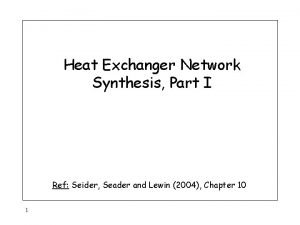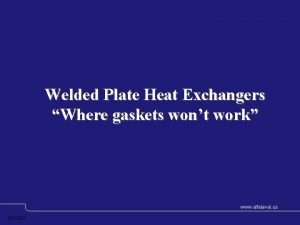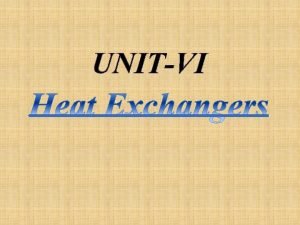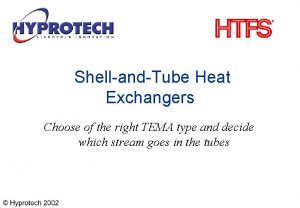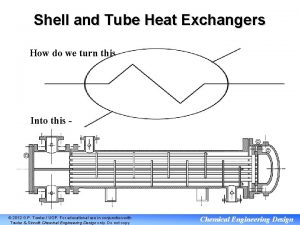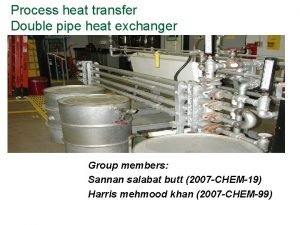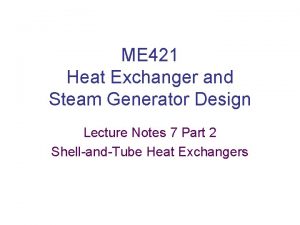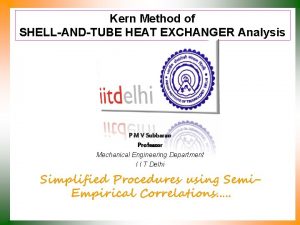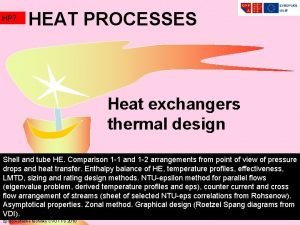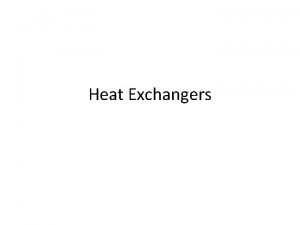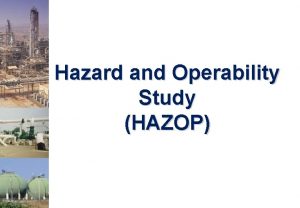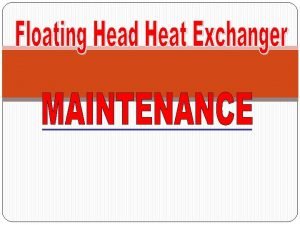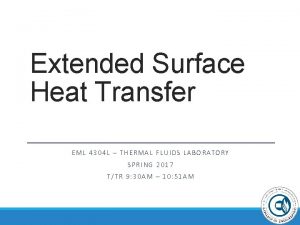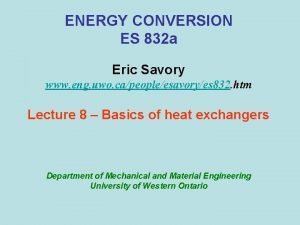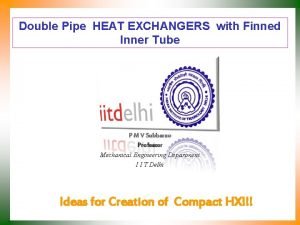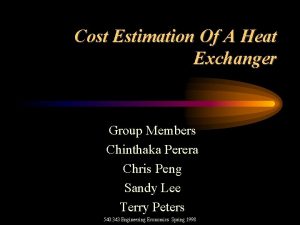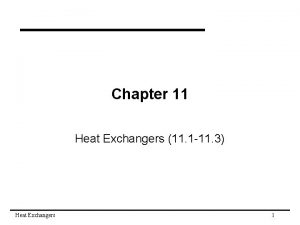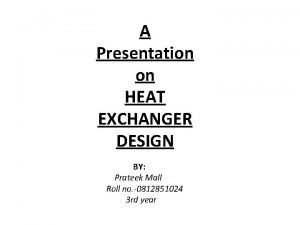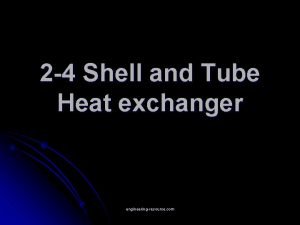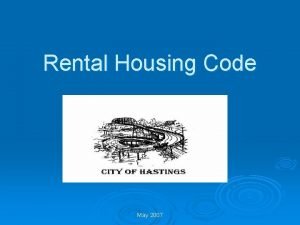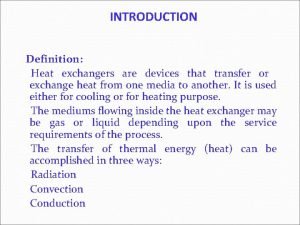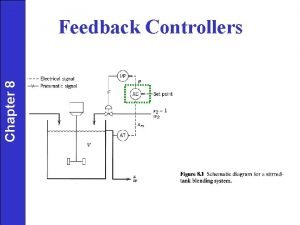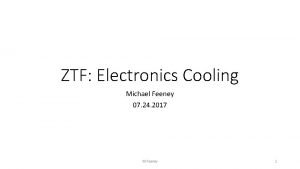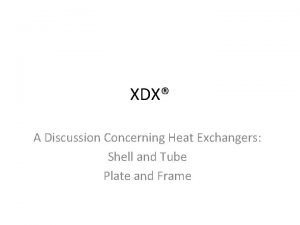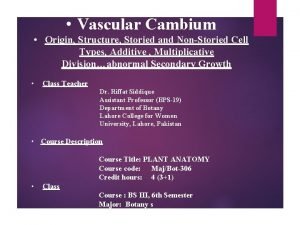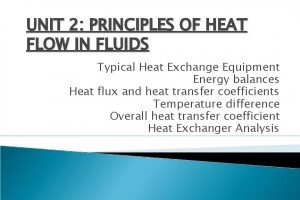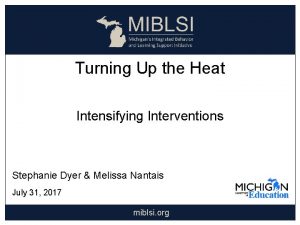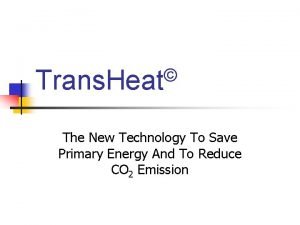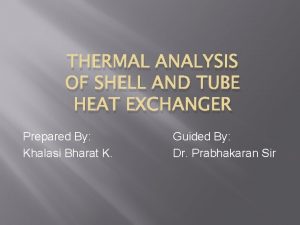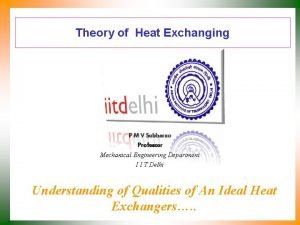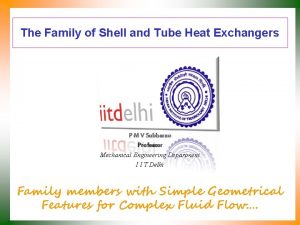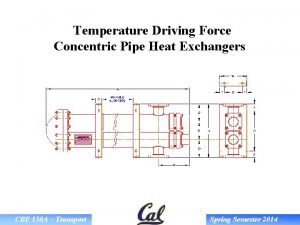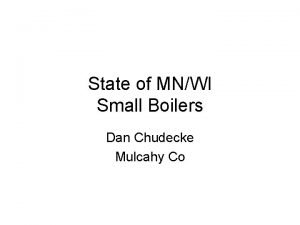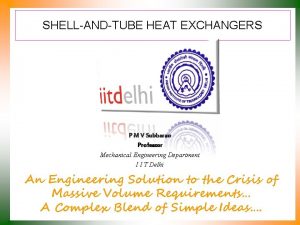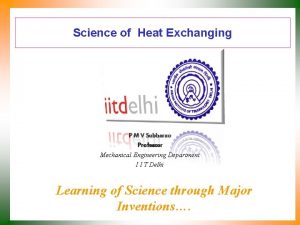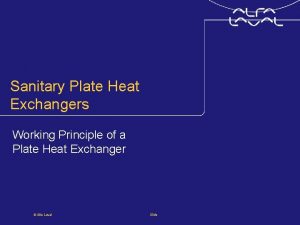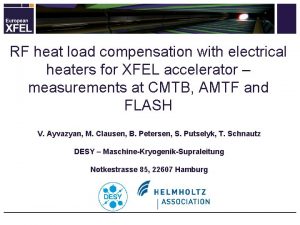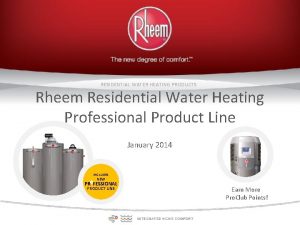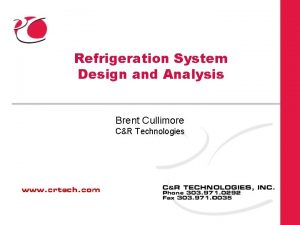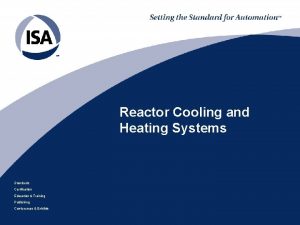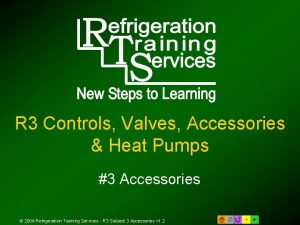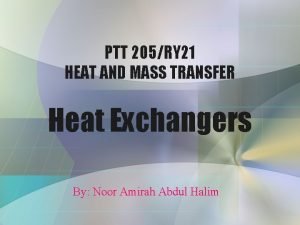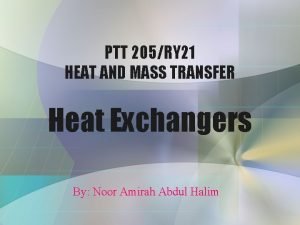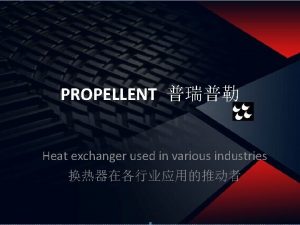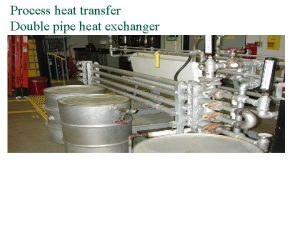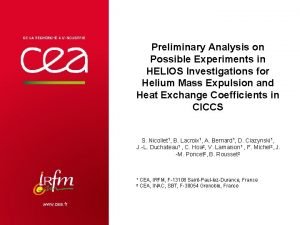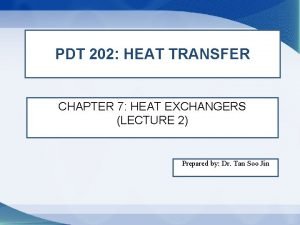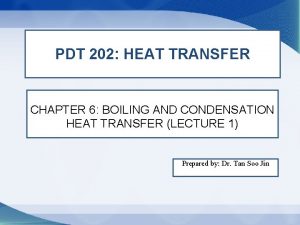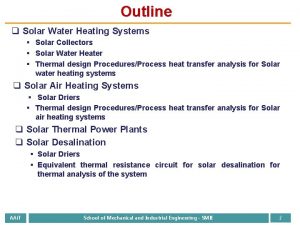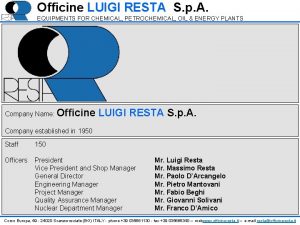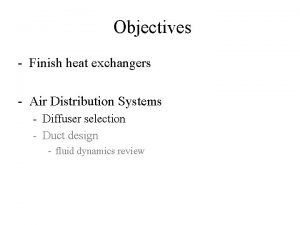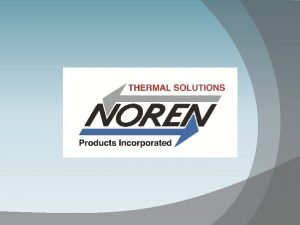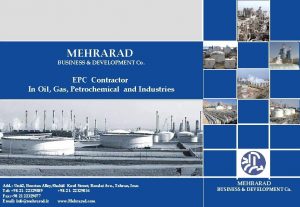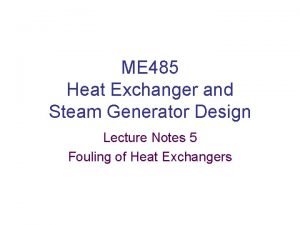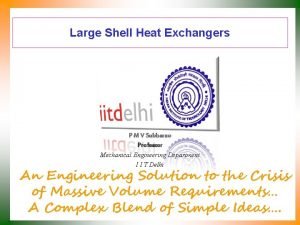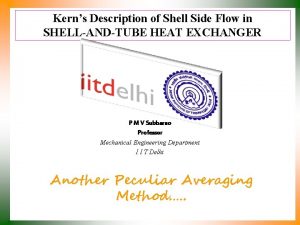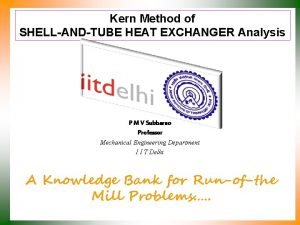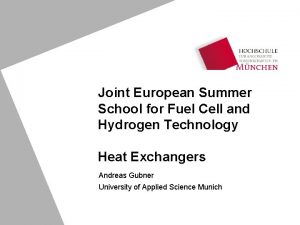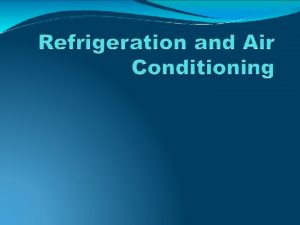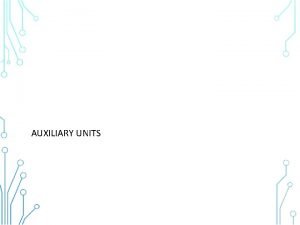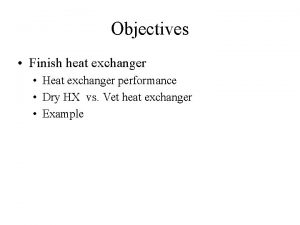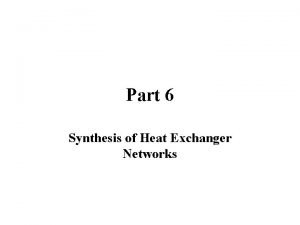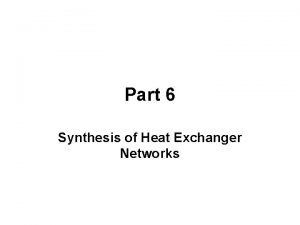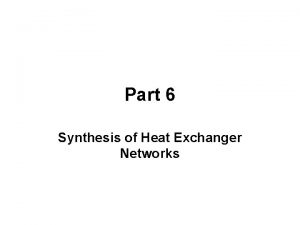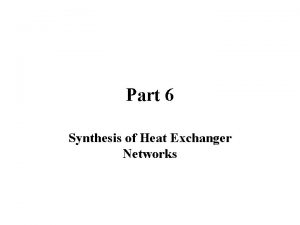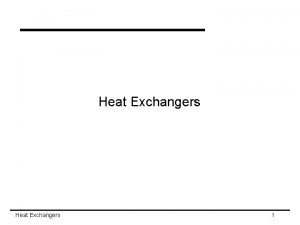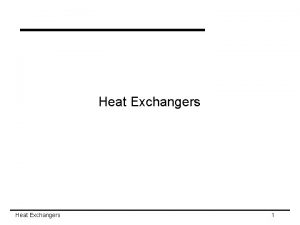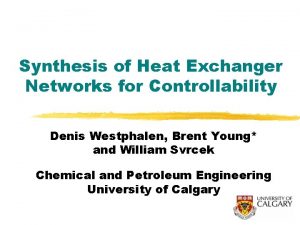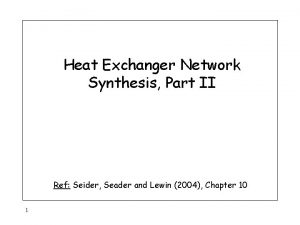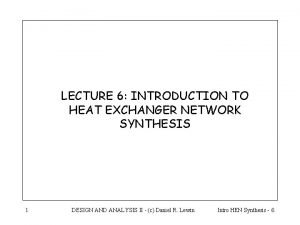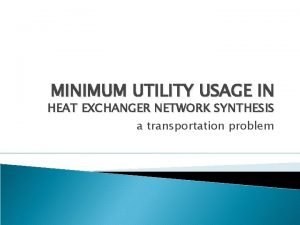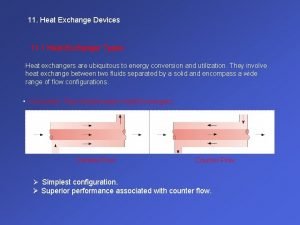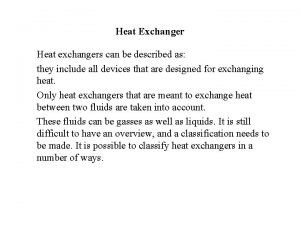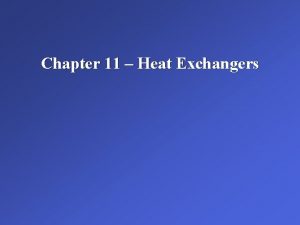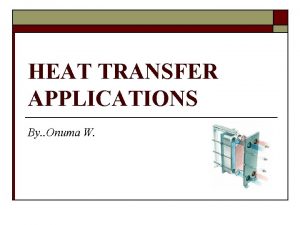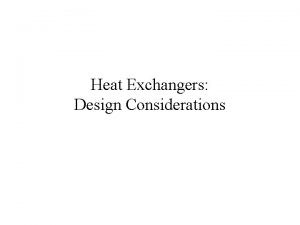Part 6 Synthesis of Heat Exchanger Networks 6



































































- Slides: 67

Part 6 Synthesis of Heat Exchanger Networks

6. 1 Sequential Synthesis Minimum Utility Cost

Example 1 H 1 1 400 120 H 2 2 340 120 C 1 1. 5 160 400 C 2 1. 3 100 250


Incidence Matrix of Directed Graph

Material Balance Around a Node

Minimum Cost Flow Problem

Transshipment Problem The transportation problem is a special case of the minimum cost flow problem, corresponding to a network with arcs going only from supply to demand nodes. The more general problem allows for arbitrary network configuration, so that flow from a supply node may progress through several intermediate nodes before reaching its destination. The more general problem is often termed the transshipment problem.


Heat Balances around Temperature Intervals (Warehouses)

Transshipment Model Total utility consumption rate LP problem

60 30 0 123 225

Index Sets


Condensed Transshipment Model Total utility cost Known

Remarks •

Example 2 (The transshipment model can be generalized to consider multiple utilities to minimize total utility cost. ) H 1 FCp (MW/K) 2. 5 Tin (K) 400 Tout (K) 320 H 2 3. 8 370 320 C 1 2. 0 300 420 C 2 2. 0 300 370 HP Steam: 500 K, $80/k. W-yr LP Steam: 380 K, $50/k. W-yr Cooling Water: 300 K, $20/k. W-yr HRAT: 10 K

HP steam 500 K 380 K


Sequential Synthesis Minimum Utility Cost with Constrained Matches (The transshipment model can be expanded so as to handle constraints on matches. )

Example 1 H 1 1 400 120 H 2 2 340 120 C 1 1. 5 160 400 C 2 1. 3 100 250


Expanded heat cascade!

Basic Ideas

Two Possible Heat. Exchange Options 1. Hot stream i and cold stream j are both present in interval k. 2. Cold stream j is present in interval k, but hot stream i is only present at higher temperature interval.

Hot stream i and cold stream j are both present in interval k

Cold stream j is present in interval 3, but hot stream i is only present at interval 2

Index Sets


Expanded Transshipment Model

Match Constraints

Modified Example 1 H 1 1 400 120 H 2 2 340 120 C 1 1. 5 160 400 C 2 1. 3 100 250

60 30 0 123 225

Condensed Transshipment Model The annual utility cost: $9, 300, 000.

Expanded heat cascade!

Expanded Transshipment Model

Expanded Transshipment Model Annual Utility Cost: $15, 300, 000 Heating Utility Load: 120 MW Cooling Utility Load: 285 MW

Sequential Synthesis Prediction of optimal matches for minimizing the unit number in HEN

Objective Function q=1, 2, …. , NP+1

Heat Balances The constraints in the expanded transshipment model can be modified for the present model: 1. The heat contents of the utility streams are given. 2. The common index i can be used for hot process and utility streams; The common index j can be used for cold process and utility streams.

Expanded Transshipment Model

Modification of Expanded Transshipment Model

Heat Balances

Logical Constraints

Solution

Example 1 Fcp (MW/C) Tin (C) Tout (C) H 1 1 400 120 H 2 2 340 120 C 1 1. 5 160 400 C 2 1. 3 100 250 Steam: 500 C Cooling water: 20 – 30 C Minimum recovery approach temperature (HRAT): 20 C

Condensed Transshipment Model

Pinch

MILP (i)

MILP (ii)

Solution

Manual Synthesis

Alternative Solution

Solve MILP without Partition

Only 5 units! One less than the previous two!

Sequential Synthesis Automatic Generation of Network Structures

Basic Ideas of Superstructure • Each exchanger in HEN corresponds to a match predicted by the MILP model (with or without pinch partition). • Each exchanger in HEN should also have as heat duty the one predicted by MILP. • The superstructure will contain the stream interconnections among the aforementioned exchangers that can potentially define all configurations. • The flow rates and temperatures of stream interconnections in superstructure will be treated as unknowns that must be determined.

Example 3 Stream Tin (K) Tout (K) Fcp (k. W/K) Heat Load (k. W) h (k. W/m^2 K) Cost ($/k. Wyr) H 1 440 350 22 1980 2. 0 - C 1 349 430 20 1620 2. 0 - C 2 320 368 7. 5 360 0. 67 - S 1 500 - 0 120 W 1 300 320 - 0 1. 0 20

Step 1 & Step 2

Superstructure for hot stream H 1

Embedded Alternative Configurations • • H 1 -C 1 and H 1 -C 2 in series H 1 -C 2 and H 1 -C 1 in series H 1 -C 1 and H 1 -C 2 in parallel with bypass to H 1 -C 2 • H 1 -C 1 and H 1 -C 2 in parallel with bypass to H 1 -C 1


Parameters and Unknowns

Equality Constraints

Inequality Constraints

Objective Function

Solution
 Heat exchanger network synthesis
Heat exchanger network synthesis Virtual circuit network
Virtual circuit network Basestore iptv
Basestore iptv Compabloc plate heat exchanger
Compabloc plate heat exchanger Recuperator type heat exchanger
Recuperator type heat exchanger Tema standard for heat exchanger
Tema standard for heat exchanger Duty of heat exchanger
Duty of heat exchanger Cocurrent flow heat exchanger
Cocurrent flow heat exchanger Steam generator heat exchanger
Steam generator heat exchanger Kern method heat exchanger design
Kern method heat exchanger design Cross flow heat exchanger
Cross flow heat exchanger Steam shell and tube heat exchanger
Steam shell and tube heat exchanger Hazop example pdf
Hazop example pdf Tubesheet heat exchanger
Tubesheet heat exchanger Extended surface heat exchanger
Extended surface heat exchanger Lmtd heat exchanger formula
Lmtd heat exchanger formula Pipe
Pipe Daikin altherma problems
Daikin altherma problems Heat exchanger cost estimation
Heat exchanger cost estimation A counterflow concentric tube heat exchanger
A counterflow concentric tube heat exchanger Regenerative type heat exchanger
Regenerative type heat exchanger 2-4 heat exchanger
2-4 heat exchanger Giannoni heat exchanger
Giannoni heat exchanger Cracked heat exchanger
Cracked heat exchanger Plate type exchanger
Plate type exchanger The controllers chapter 8
The controllers chapter 8 Parker heat exchanger
Parker heat exchanger Plate type exchanger
Plate type exchanger Water to water heat exchanger
Water to water heat exchanger Storied and non storied cell types slideshare
Storied and non storied cell types slideshare Shell and tube type condenser
Shell and tube type condenser Rusty heat exchanger
Rusty heat exchanger Standard xchange heat exchanger
Standard xchange heat exchanger Shell tube evaporator
Shell tube evaporator Simple heat exchanger
Simple heat exchanger Triple pipe heat exchanger
Triple pipe heat exchanger Concentric double pipe heat exchanger
Concentric double pipe heat exchanger Viessmann heat exchanger
Viessmann heat exchanger Tubesheet heat exchanger
Tubesheet heat exchanger Cross counter flow heat exchanger
Cross counter flow heat exchanger Simple heat exchanger
Simple heat exchanger Plate heat exchanger working principle
Plate heat exchanger working principle Propane heat exchanger
Propane heat exchanger Rheem heat exchanger
Rheem heat exchanger Sinda fluint
Sinda fluint Dsqr certification
Dsqr certification Rusty heat exchanger
Rusty heat exchanger Cross flow heat exchanger
Cross flow heat exchanger A double pipe parallel flow heat exchanger
A double pipe parallel flow heat exchanger Wide-runner heat exchanger
Wide-runner heat exchanger A double pipe parallel flow heat exchanger
A double pipe parallel flow heat exchanger Counter flow heat exchanger
Counter flow heat exchanger Steam condenser heat exchanger
Steam condenser heat exchanger Pool heat exchanger for boiler
Pool heat exchanger for boiler Subsoil heat exchanger
Subsoil heat exchanger Solar hot water heat exchanger
Solar hot water heat exchanger Breech lock exchanger
Breech lock exchanger Redofin
Redofin Noren heat exchanger
Noren heat exchanger Passive heat exchanger
Passive heat exchanger Shell and tube heat exchanger in oil refinery
Shell and tube heat exchanger in oil refinery Heat recovery steam generator fouling
Heat recovery steam generator fouling Shell and tube heat exchanger in food industry
Shell and tube heat exchanger in food industry S&t heat exchanger
S&t heat exchanger Equivalent diameter shell tube heat exchanger
Equivalent diameter shell tube heat exchanger Standard heat exchanger
Standard heat exchanger In a parallel flow heat exchanger
In a parallel flow heat exchanger Standard refrigeration heat exchanger
Standard refrigeration heat exchanger
